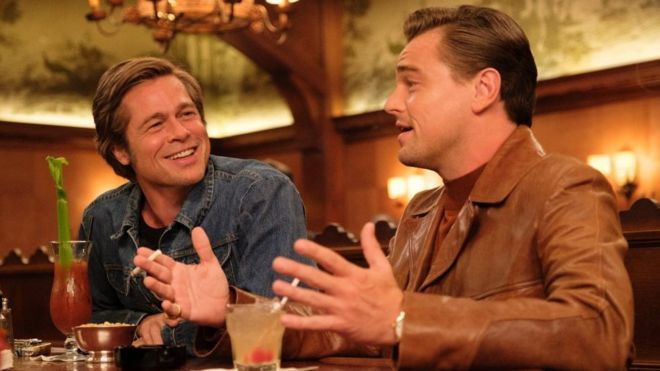'Once Upon a Time in Hollywood': Self-gratifying farce meanders, goes out with fizzle
Quentin Tarantino’s ninth, and possibly penultimate film before retiring pushes everything that has made the director such a distinctive voice in cinema – his fascination with the “old ways”, his textual and metatextual hat-tipping to his cinematic ancestors – to its limits
Change Size
 Brad Pitt (left) and Leonardo DiCaprio in 'Once Upon a Time in Hollywood'. (Courtesy of/Sony Pictures)
Brad Pitt (left) and Leonardo DiCaprio in 'Once Upon a Time in Hollywood'. (Courtesy of/Sony Pictures)
O
ver the years, the cinema of Quentin Tarantino has become synonymous with How Movies Were Back Then – a wistful look back at the formative decades of film history.
The prominent American auteur’s nostalgic proclivities have extended beyond his textual callbacks to a cadre of cinematic influences, to the nitty-gritty of how he positioned and marketed his films. Consider, for example, how he insisted on rolling out roadshow premieres of The Hateful Eight (2015) which he shot in anamorphic 70mm, at a time when the vast majority of studio blockbusters banked on special formats promising improved viewer immersion like IMAX or 3D. Nostalgia, it seems, is what makes Tarantino tick.
For a while, Tarantino’s old-school approach to filmmaking was novel, even inspired. His quaint aesthetic preferences, which are themselves hand-me-downs from his predecessors, used to stand in stark contrast to the rest of contemporary cinema. Tarantino turned what was ordinary in the days of yore into his own defining signatures.
Read also: The best of the Tarantino cinematic universe
Tarantino’s ninth, and possibly penultimate film before retiring pushes everything that has made the director such a distinctive voice in cinema – his fascination with the “old ways”, his textual and metatextual hat-tipping to his cinematic ancestors – to its limits. Titled Once Upon a Time in Hollywood, the most Tarantino-esque film title of them all, sees the filmmaker recreate in meticulous detail the last days of the so-called Golden Age of Hollywood in the notoriously tumultuous late 1960s.
It’s the definitive culmination of Tarantino’s thematic and stylistic preoccupations: Not only does he reference the past from a safe distance, but he also steps into and immerses himself (along with the viewer) in it.
The film weaves at least three separate storylines, all taking place in Los Angeles circa 1969. One concerns fading fictional Hollywood superstar Rick Dalton (Leonardo DiCaprio) and his stuntman-cum-confidante Cliff Booth (Brad Pitt) as they attempt to navigate the rapidly changing industry. Another chronicles the conflict-free everyday life of actor Sharon Tate (Margot Robbie) – controversial filmmaker Roman Polanski’s late wife, whose shocking murder in the hands of the Manson Family has been so ingrained in real-life public consciousness. There’s also a subplot involving Charles Manson’s infamous band of hippies that ties the film together.
Once Upon a Time in Hollywood is not Tarantino’s first foray into multinarrative storytelling. If anything, he helped popularize it with what is widely considered to be his most popular film, Pulp Fiction (1994). However, unlike his previous works, Tarantino’s latest outing fails to say anything remotely interesting despite its specific real-world setting. The majority of Once Upon a Time in Hollywood’s bloated duration is either spent on showing A-listers’ verbal and occasionally physical altercations with each other (got to start saving up those Best Actor/Actress reels for awards season, I guess) or the minutiae of their mundane activities – there’s an extended sequence that sees Brad Pitt’s character feed his pet pit bull in his shabby trailer that plays out like a deleted scene from the film’s DVD extras.
One could make a case for the film’s disregard for any narrative impetus, that its slack screenplay and leisurely pacing are exactly its point as it presents an opportunity for those who fondly remember the late 1960s to enjoy a prolonged stay in its artificial recreation of the era. To this viewer, however, there’s little enjoyment to be found in Tarantino’s indulgent reproduction of period textures and iconography that are clearly very dear to the director’s heart. At one point, the film becomes overly cluttered with deep-cut references to the era, gleefully inserting fictional characters into clips of real-life pop-cultural artifacts, like a kid making fan-edits of their favorite films which he would then upload to YouTube.
This is where the viewer is prompted to ask: To what end? Sure, films have the power to interrogate and revise known history. But when they are as meandering and excruciatingly interminable as Tarantino’s latest, cinema will surrender to a deep slumber sooner than it can change the world. (kes)









